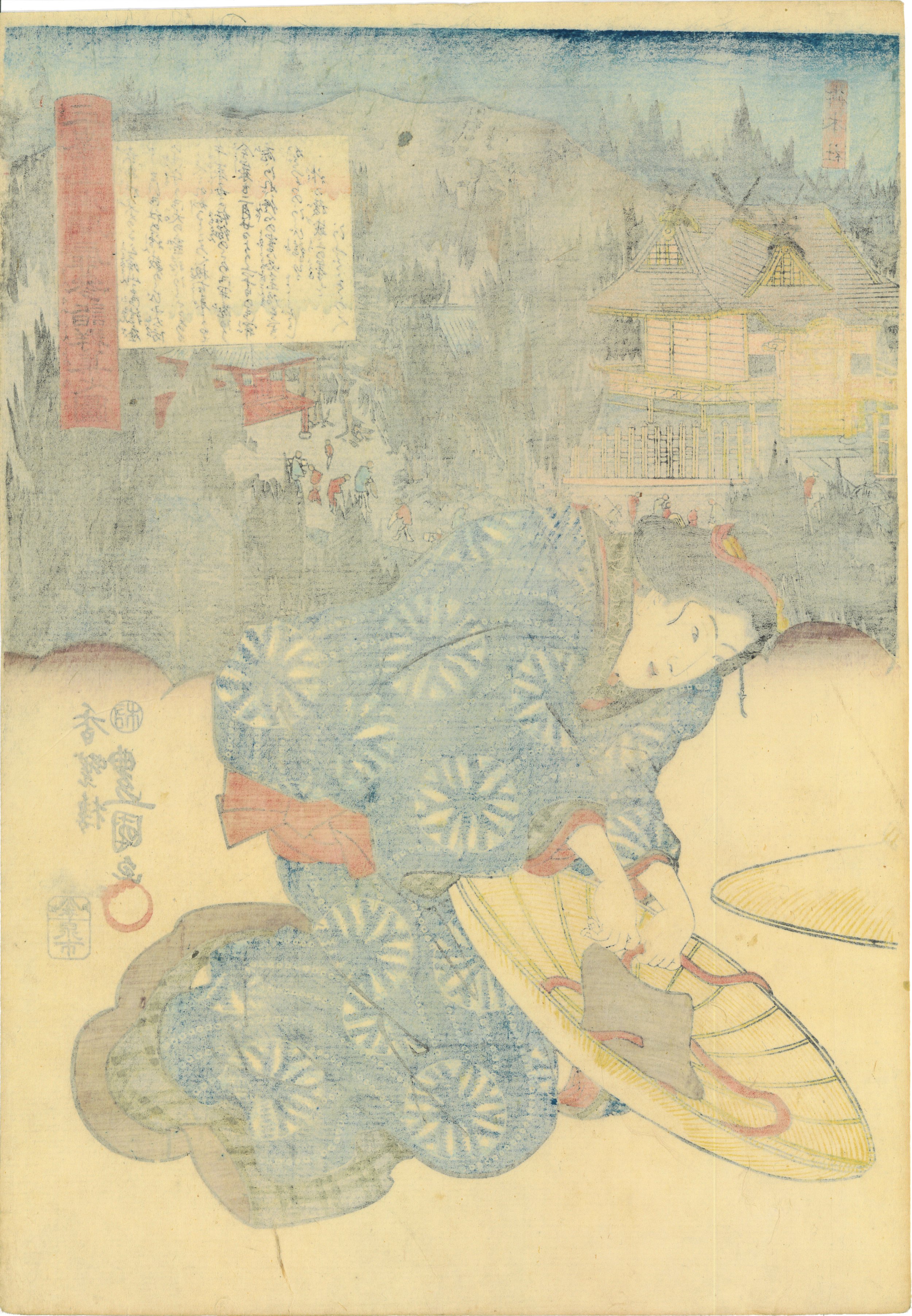Kunisada (Toyokuni III) | Group of Pilgrims Going to the Mitsumine Shrine for a Special Viewing
三代目歌川豐国 Utagawa Kunisada (1786–1865)
三峰山御开扉参詣群集之图
Group of Pilgrims Going to the Mitsumine Shrine for a Special Viewing
1843-47
木版画 | 三联续绘-纵绘大判 | 37cm x 25cm x 3
Woodblock-print | Triptych Oban tate-e triptych | 37cm x 25cm x 3
早期版次;品相非常好;有一处轻微折痕
Early impression; great condition; one light crease
$2,200
三峯山,即三峰山,埼玉县秩父市周边奥秩父山地的妙法岳、白岩山及云取山的合称。其上的三峰神社据传始建于公元1世纪左右的景行天皇期间,与秩父神社、宝登山神社并称为秩父三大神社,主祭神为伊邪那岐与伊邪那美。同时,因此地将狼(山犬)作为守护神,故社内供奉有一众神狼雕像用于镇守,而非大部分神社中的狛犬。自古以来,秩父山区便栖息着许多日本狼(1905年灭绝),因其多以野猪等兽类为食,故被当地百姓视为护佑农作物免受害兽侵扰的神灵,并被尊称为“阿犬大人”;江户中期,随着高僧日光法印对此信仰的进一步传播,狼更是被广泛认可为避盗免灾之神,一时间全国信众无数,三峰山及三峰神社随即声名远播。每逢三峰神社开放参拜,关东与东北地区的信众便会蜂拥而至。您瞧,画中的三位女子经过一路风尘仆仆,脱去头戴的斗笠,卸下担上的箱篋包袱,拍一拍华美衣装上的尘土,终于来到了心向往之的三峰神社前。背景的神社内早已人头攒动,一批又一批的信众参拜其中,以祈求神灵的护佑。从建筑间密生的茂盛树木来看,这里的确是日本狼们繁衍生息的好所在。在山林间自由奔跑的它们,是否知道自己承载着人们的万千祈愿呢?
Interested in purchasing?
Please contact us.
三代目歌川豐国 Utagawa Kunisada (1786–1865)
三峰山御开扉参詣群集之图
Group of Pilgrims Going to the Mitsumine Shrine for a Special Viewing
1843-47
木版画 | 三联续绘-纵绘大判 | 37cm x 25cm x 3
Woodblock-print | Triptych Oban tate-e triptych | 37cm x 25cm x 3
早期版次;品相非常好;有一处轻微折痕
Early impression; great condition; one light crease
$2,200
三峯山,即三峰山,埼玉县秩父市周边奥秩父山地的妙法岳、白岩山及云取山的合称。其上的三峰神社据传始建于公元1世纪左右的景行天皇期间,与秩父神社、宝登山神社并称为秩父三大神社,主祭神为伊邪那岐与伊邪那美。同时,因此地将狼(山犬)作为守护神,故社内供奉有一众神狼雕像用于镇守,而非大部分神社中的狛犬。自古以来,秩父山区便栖息着许多日本狼(1905年灭绝),因其多以野猪等兽类为食,故被当地百姓视为护佑农作物免受害兽侵扰的神灵,并被尊称为“阿犬大人”;江户中期,随着高僧日光法印对此信仰的进一步传播,狼更是被广泛认可为避盗免灾之神,一时间全国信众无数,三峰山及三峰神社随即声名远播。每逢三峰神社开放参拜,关东与东北地区的信众便会蜂拥而至。您瞧,画中的三位女子经过一路风尘仆仆,脱去头戴的斗笠,卸下担上的箱篋包袱,拍一拍华美衣装上的尘土,终于来到了心向往之的三峰神社前。背景的神社内早已人头攒动,一批又一批的信众参拜其中,以祈求神灵的护佑。从建筑间密生的茂盛树木来看,这里的确是日本狼们繁衍生息的好所在。在山林间自由奔跑的它们,是否知道自己承载着人们的万千祈愿呢?
Interested in purchasing?
Please contact us.
三代目歌川豐国 Utagawa Kunisada (1786–1865)
三峰山御开扉参詣群集之图
Group of Pilgrims Going to the Mitsumine Shrine for a Special Viewing
1843-47
木版画 | 三联续绘-纵绘大判 | 37cm x 25cm x 3
Woodblock-print | Triptych Oban tate-e triptych | 37cm x 25cm x 3
早期版次;品相非常好;有一处轻微折痕
Early impression; great condition; one light crease
$2,200
三峯山,即三峰山,埼玉县秩父市周边奥秩父山地的妙法岳、白岩山及云取山的合称。其上的三峰神社据传始建于公元1世纪左右的景行天皇期间,与秩父神社、宝登山神社并称为秩父三大神社,主祭神为伊邪那岐与伊邪那美。同时,因此地将狼(山犬)作为守护神,故社内供奉有一众神狼雕像用于镇守,而非大部分神社中的狛犬。自古以来,秩父山区便栖息着许多日本狼(1905年灭绝),因其多以野猪等兽类为食,故被当地百姓视为护佑农作物免受害兽侵扰的神灵,并被尊称为“阿犬大人”;江户中期,随着高僧日光法印对此信仰的进一步传播,狼更是被广泛认可为避盗免灾之神,一时间全国信众无数,三峰山及三峰神社随即声名远播。每逢三峰神社开放参拜,关东与东北地区的信众便会蜂拥而至。您瞧,画中的三位女子经过一路风尘仆仆,脱去头戴的斗笠,卸下担上的箱篋包袱,拍一拍华美衣装上的尘土,终于来到了心向往之的三峰神社前。背景的神社内早已人头攒动,一批又一批的信众参拜其中,以祈求神灵的护佑。从建筑间密生的茂盛树木来看,这里的确是日本狼们繁衍生息的好所在。在山林间自由奔跑的它们,是否知道自己承载着人们的万千祈愿呢?
Interested in purchasing?
Please contact us.
Utagawa Toyokuni III (1786–1865)
In the pantheon of Japanese woodblock prints, some names loom large and legendary – Hokusai, Hiroshige, Utamaro, to name a few. Each in his own way revolutionized his genre. But for sheer productivity and quality and longevity, no one rivals the great Utagawa Kunisada. He was without a doubt the most prolific Ukiyo-e artist of the Edo period, and the quality of his work was remarkably high throughout his lifetime.
His life caught the tail end of the early golden age of Ukiyo-e and ended during the final, halcyon days of Japanese woodblock printmaking. His legacy lived on with many famous pupils. In between, he produced countless designs of bijin (beautiful women), warriors, legends, Surimono, more bijin, the Tale of Genji, actors, landscapes, Shunga, fan prints and even more bijin. He led the Utagawa School, home to Hiroshige among others, for nearly 40 years.
His work embraced a subtle elegance and simplicity, a timelessness, when other woodblock artists often favored busy energy. Except when it didn’t. (Read on.)
He was born in 1796 and always had a steady income from his family’s ferry business – making him unusual in the world of Ukiyo-e, where so many struggled to make ends meet. He became a student of Toyokuni when he was 15. The master gave him the name Kunisada, using the tradition of a teacher starting a student’s name with the end of his own.
After getting his start doing book designs, Kunisada saw his first major successes in the 1820s. His initial specialties were bijin and warriors, as well as erotic books. He often put his subjects in well-drawn landscapes but rarely produced pure landscapes themselves.
One example of this occurred in the early 1830s when, reacting to the runaway success of Hiroshige’s Great Tokaido series, he began his own series that copied Hiroshige’s designs but placed a beautiful woman in the foreground. While Hiroshige’s prints were oban yoko-e (horizontal oban prints), Kunisada’s “copies” were smaller chuban-size prints, meaning two could be cut from a single oban-sized sheet. These little prints were phenomenally successful – as successful at least as Hiroshige’s – and eventually Kunisada was publishing his little Tokaido prints ahead of Hiroshige’s, and thus designing his own background landscapes.
Kunisada would later produce the “two-brush” Tokaido series with Hiroshige in the 1850s, in which he drew figures in the foreground while Hiroshige supplied beautiful little landscapes behind them. This was one of several notable woodblock print collaborations during his lifetime.
By then, Kunisada had taken the name Toyokuni III, to honor his master. (Toyokuni II had already been taken by Toyoshige, though Kunisada didn’t acknowledge the legitimacy. But that’s another story for another day.)
He kept going and going. In fact, in his long life, 1852 was his most productive year. His design skills were later matched by new technologies in woodblock prints, and some of his final series feature spectacular and intricate production, such as “Lasting Impressions of a Later Genji Collection” in 1859-61 and “A Contest of Magic Scenes by Toyokuni” in 1861-4. Okay – this series was not subtle: It featured over-the-top designs of Kabuki actors with fabled and ghostly beasts. Double-printing, mica, burnishing, raised printing, heavy paper, complex bokashi – no expense was spared for these deluxe editions.
Kunisada was generous with his students, many of whom went on to great success, including Kunichika, Kunisada II, Sadahide, and Kunihisa II. This last pupil, who among other projects designed the in-set landscapes in Kunisada’s wonderful “100 Famous Sights in Edo Matched with Beautiful Women” in 1857-1858, was a rarity among Ukiyo-e artists – a woman.
Kunisada died in 1865, just three years before the end of the Tokugawa epoch, leaving behind a body of work unmatched in his time.
Don’t believe me? Checkout The Kunisada Project. It’s all there. Just make sure you have some time.
Citation: Research for this brief biography included “Japanese Woodblock Prints” by Andreas Marks (Tuttle; 2010), among other sources.








